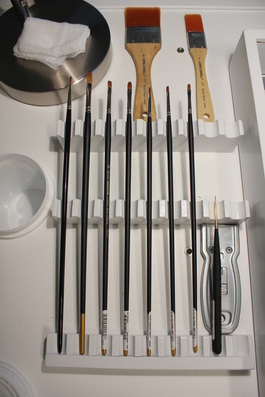Dust
One
of the many struggles one will face when painting is keep dust out of
your painted surface. What makes it
difficult is that it's everywhere and impossible to completely remove from your
work area. But there are ways to minimize it substantially.
First of all, what is dust? If you are painting indoors like I do, dust will come from anything like paper fibers, lint from clothing, hair, and skin cells. I've read that anywhere from 70 - 90% of household dust comes from you! That's right you! As a human with skin, you are constantly shedding dead skin cells. It can also come from pets in the home too! Personally, I don't like to think about what the dust is made of since it kinda grosses me out, but nevertheless one needs to be aware of it if your goal is to create a professional looking painting.
When I first started focusing on creating tight, trompe l' oeil type paintings, I began to notice how annoying it was seeing dust in my painting. Being in a large studio environment in school with other artists, I noticed keeping dust away was sometimes completely out of my control. At the time, I was working on relatively small paintings (7" x 7" to 12" x 16") with simple white backgrounds which made any small piece of fuzz, lint, or hair easy to see. It was not until I started working in my own studio where I could better manage dust.
First of all, what is dust? If you are painting indoors like I do, dust will come from anything like paper fibers, lint from clothing, hair, and skin cells. I've read that anywhere from 70 - 90% of household dust comes from you! That's right you! As a human with skin, you are constantly shedding dead skin cells. It can also come from pets in the home too! Personally, I don't like to think about what the dust is made of since it kinda grosses me out, but nevertheless one needs to be aware of it if your goal is to create a professional looking painting.
When I first started focusing on creating tight, trompe l' oeil type paintings, I began to notice how annoying it was seeing dust in my painting. Being in a large studio environment in school with other artists, I noticed keeping dust away was sometimes completely out of my control. At the time, I was working on relatively small paintings (7" x 7" to 12" x 16") with simple white backgrounds which made any small piece of fuzz, lint, or hair easy to see. It was not until I started working in my own studio where I could better manage dust.
|
Before I paint any new layers on to my piece, I wipe both the palette and dried painting surface with a tack cloth. A tack cloth is a piece of cheese cloth treated with a tacky material that attracts dust. The tacky substance is a resin material; don't worry, this won't harm you or your painting. Tack clothes are used in every wood shop and automotive body shop. They are extremely effective at removing dust and bits of fuzz from your projects. By gently dabbing the surface of your painting with a tack cloth, you will eliminate all dust. You can pick them up at your local hardware store for about $1.
Another way to help keep dust out of paint is to use clean brushes. This should be common knowledge, but I have never read or heard it instructed anywhere. If your brushes are sitting out for any length of time, they will accumulate dust. Take 5 minutes and wash dirty/dusty brushes before you use them. Its also helpful to use lint free cloths or paper towel during painting to wipe your brushes.
|
|
|
To prevent dust from collecting on your palette, cover it up. When I made my painting table, I built it with a hinged cover to seal out dust when I'm not painting. You can see more about the palette cover by clicking the button below.
The final way to rid your painting of dust is to physically remove it once you see it in your paint on the canvas. I know this sound picky but it something that I feel is necessary in my work. Anytime I see a fuzzy or hair in the paint, I lift it out with the tip of my brushe. Its time consuming, but worth it to have a smooth surface. Once I'm done working for the day, I remove the painting from my easel and put it in my drying rack where the wet paint is less likely to catch dust in the air.
|



